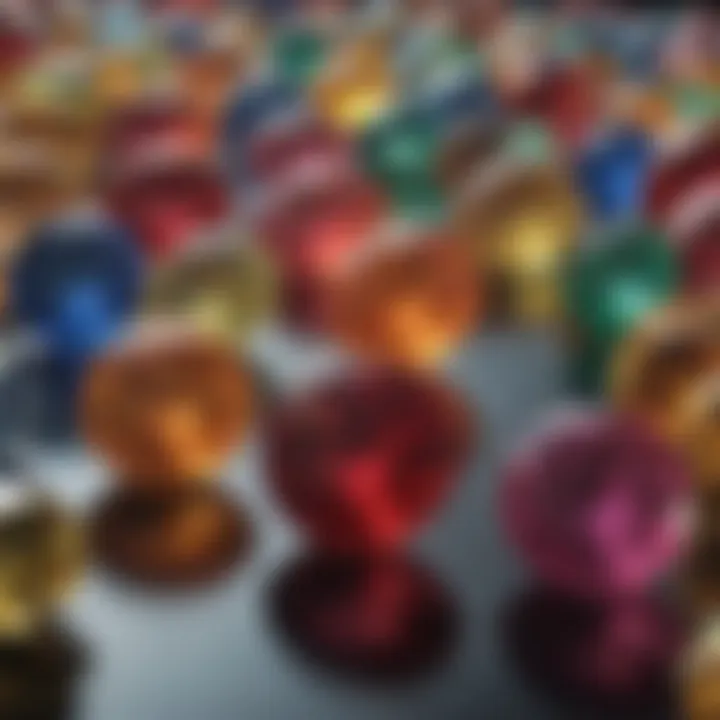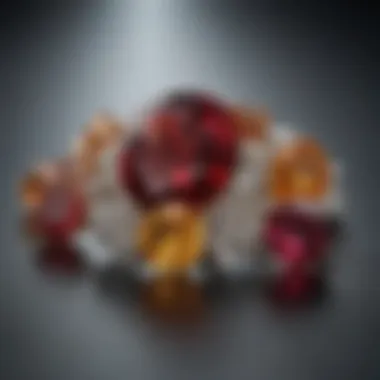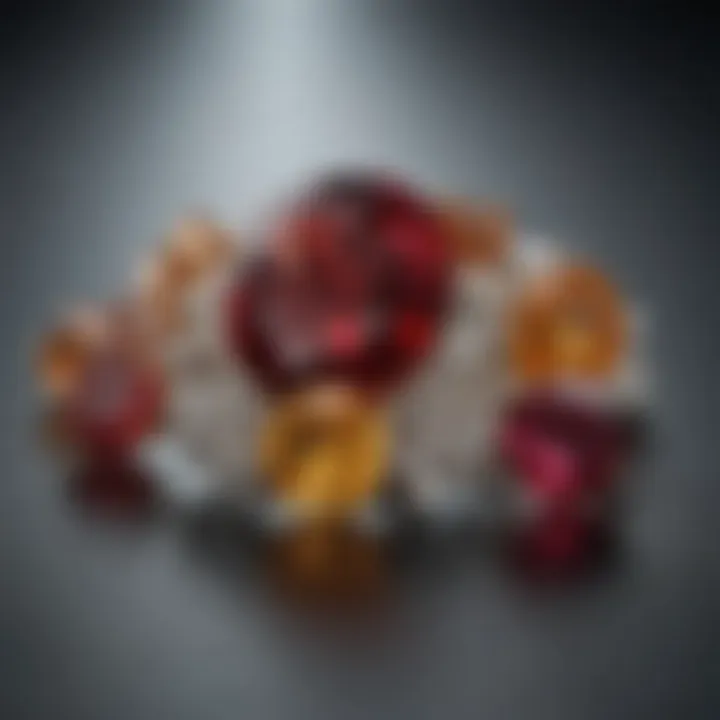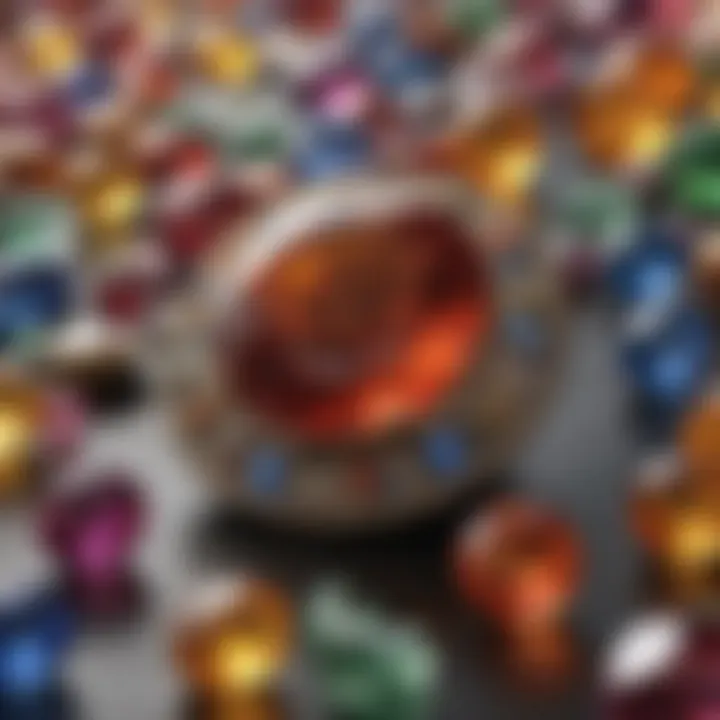Discovering November Birthstones: Meaning and Choices


Intro
When it comes to birthstones, November shines with its unique offerings that resonate deeply with characteristics and symbolism. The two primary birthstones for November, topaz and citrine, are more than mere gemstones; they encapsulate centuries of history, culture, and even spiritual significance. This article takes a closer look at these luminous stones, their origins, and what they mean to those born in this vibrant month. In exploring these gems, we understand not only their aesthetic appeal but also their rich narratives that resonate with jewel enthusiasts, collectors, and designers alike.
Gemstone Overview
Definition of Gemstones
Gemstones are naturally occurring minerals, organic materials, or rocks that have been cut and polished for decoration. Their beauty and rarity often elevate them in value, making them desirable in jewelry and other ornamental uses. They can vary widely in composition, hardness, and color, reflecting the intricate tapestry of Earth's geological processes.
Classification of Gemstones
Gemstones can be categorized in several ways:
- Precious Stones: Often considered the elite of gemstones, this group usually includes diamonds, rubies, sapphires, and emeralds. They are distinguished by their rarity, durability, and beauty.
- Semi-Precious Stones: This classification encompasses a broader array of stones like amethyst, garnet, and of course, topaz and citrine, which are the focus for November.
- Organic Gemstones: Unlike their mineral counterparts, these are derived from living organisms. For instance, pearls and amber fall under this category, showcasing the diversity in gemstone origins.
"Every gemstone carries a story forged through time, geology, and human culture, making each one unique."
Historical Significance
Origins of Gemstone Use
The practice of adorning oneself with gemstones dates back thousands of years. Ancient civilizations harnessed the beauty and perceived powers of these stones, crafting them into jewelry and talismans that adorned royalty and commoners alike. For instance, in ancient Egypt, lapis lazuli symbolized the night sky and was used in burial artifacts, while traditional cultures around the world believed various stones held protective properties.
Cultural Insights: Gemstones in Ancient Civilizations
Across the globe, gemstones have played pivotal roles in culture and philosophy:
- In Mesopotamia, the belief that certain stones could ward off evil spirits originated with garnets and turquoise.
- Greeks and Romans placed great importance on their gemstones, linking them to the gods and weaving them into their myths. Amethyst, for instance, was believed to protect against drunkenness.
- In Eastern cultures, particularly in India, gemstones are often associated with astrology. For example, the blue sapphires and yellow topaz are considered essential for specific zodiac signs, impacting one's destiny.
As we navigate the landscape of gemstones through history, it’s clear that these stones are steeped in relevance and intrigue, setting the stage for understanding the captivating birthstones linked to November.
Understanding Birthstones
Understanding the concept of birthstones is crucial for anyone interested in gemstones, whether they are collectors, jewelry designers, or enthusiasts. These stones are not just visually appealing; they carry a weight of significance rooted in history, culture, and personal symbolism. By learning about birthstones, one gains insight into their origins, meanings, and the myriad of choices available for personal adornment. This knowledge enhances appreciation for gemstones, making each piece more than just an accessory—it's a story, a tradition, and, for many, a source of personal strength.
Definition and Historical Context
One might ask, what exactly defines a birthstone? At its core, a birthstone is a gemstone traditionally associated with a specific month in the calendar year. Each stone holds unique attributes and has varying meanings across different cultures.
Historically, the practice of associating specific stones with birth months dates back to ancient times. The biblical Book of Exodus mentions the breastplate of Aaron, which featured twelve stones, each representing a tribe of Israel. Later, these stones became linked to the zodiac signs and eventually culminated in our modern concept of birthstones.
In more recent years, the American National Retail Jewelers Association, in 1912, formalized the list of birthstones that we recognize today. The historical gravitas attached to these stones adds depth to their modern interpretations, reminding us of their ancient roots.
How Birthstones are Assigned
The assignment of birthstones isn’t arbitrary; it follows a blend of tradition, astrology, and historical significance. The stones associated with each month reflect seasonal changes, cultural traits, and even astrological influences. For November, for instance, the traditional birthstone actually is Topaz, thought to embody strength and wisdom. In contrast, the modern alternative, Citrine, evokes feelings of warmth and vitality, symbolizing hope and optimism.
These associations have evolved over centuries, often influenced by regional variations. As a result, in some cultures, you may find different stones recognized for the same month, creating a rich tapestry of meanings and choices available to individuals looking to associate their birth month with a special gemstone.
Cultural Significance of Birthstones


The cultural significance of birthstones extends beyond their physical attributes. Different cultures have ascribed various meanings to each stone. In some cases, these meanings are deeply tied to beliefs in protection, prosperity, and healing.
For instance, in many eastern cultures, Topaz is believed to facilitate harmony and balance in relationships, while Citrine is often seen as a stone of positivity and abundance.
Moreover, the emotional value placed on these stones makes them really meaningful gifts. In engagements and anniversaries, giving a piece associated with one's birthstone can underscore personal connections, presenting a thoughtful token that speaks to familial ties or individual identity.
"Each birthstone represents a unique part of who we are—our histories, our relationships, and our cultural backgrounds. They are more than just rocks; they encapsulate human experiences and traditions across generations."
November Birthstones Overview
The month of November is adorned with two distinct birthstones: Topaz and Citrine. Both of these gemstones contribute not just to the allure of jewelry but also carry substantial meanings and histories that enrich their selection. Understanding these stones' qualities and significance can assist gem enthusiasts and collectors in making informed decisions regarding their acquisitions.
Topaz is traditionally recognized as the main birthstone for November. Its range of colors and clarity has captivated jewelers and buyers alike for centuries. Beyond aesthetics, Topaz holds a reputation steeped in historical importance and metaphysical beliefs, believed by some to promote calmness and clarity.
In contrast, Citrine, the modern birthstone, is celebrated for its vibrant yellow and golden hues. It is often associated with positivity and abundance, which resonates with many who seek to harness its energetic properties. The choice between these two stones can be influenced by individual preferences, intended use, or even the desired emotional or spiritual benefits.
Caring for these precious stones also requires knowledge and awareness of their unique qualities. The way one chooses to set these stones can enhance their beauty further and represents a chance for personal expression in jewelry design. Therefore, exploring November birthstones goes beyond mere selection; it involves deep dives into their characteristics, historical contexts, and metaphysical significances. Understanding these aspects will enrich your appreciation for Topaz and Citrine and empower you in making well-informed jewelry choices that reflect your style and intentions.
"Jewelry is not just an accessory; it is an intimate expression of one’s personality and experiences."
Traditional November Birthstone: Topaz
Topaz should be recognized for its broad spectrum of colors, including crystal clear, blue, and golden hues. The most coveted of these is often the imperial topaz, a rich orange-yellow shade that symbolizes the very essence of luxury. Historically, this gem was believed to bring strength and protection. Wealthy patrons in ancient times wore it as a talisman against harm, believing that Topaz would calm heated tempers and dispel negativity.
When looking at Topaz, consider its hardness; it ranks an admirable eight on the Mohs scale, indicating that it can withstand everyday wear quite well if cared for properly. For jewelry, Topaz pairs exquisitely with a variety of metals, allowing it to shine even more brightly. Often, designers opt for intricate settings that highlight its multifaceted nature, transforming a simple stone into a stunning statement piece.
Modern November Birthstone: Citrine
Citrine offers a lively burst of energy with its iconic sunny yellows and rich golds, often drawing comparisons to sunlight and positivity. It resonates deeply with those seeking a brighter outlook on life or infusing a space with warmth and vibrancy. Historically, Citrine was traded along ancient routes, favored for its ability to promote prosperity and success. Merchants in the past would wear it as a protective stone during their dealings.
In terms of jewelry, Citrine's alluring colors can be found in various cuts and styles. Its quality can range from pale yellow to deep amber, creating a spectrum that suits any taste. Most notably, Citrine is less expensive and more accessible compared to many other gemstones, making it an attractive choice for those who appreciate beauty without breaking the bank. Its resilience also ensures that it stands the test of time in every piece, whether it's a ring or pendant.
Topaz: The Classic November Birthstone
Topaz stands as a beacon of beauty among November birthstones, celebrated not only for its striking aesthetic but also for the myriad of meanings attributed to it. This gemstone has woven itself into the cultural, historical, and even spiritual fabric of societies throughout time. Recognized for its warm hues and remarkable clarity, Topaz not only catches the eye but captivates the heart. This section will delve into the various characteristics, historical significance, and metaphysical properties of Topaz, shedding light on why it remains a favorite for enthusiasts and collectors alike.
Characteristics and Varieties
Topaz is a silicate mineral primarily composed of aluminum and fluorine. It comes in a plethora of colors, from the vibrant yellows and oranges to cool blues and even colorless varieties. The most renowned among these is often the imperial topaz, known for its rich gold to reddish shades. Each color carries a unique charm, appealing to different tastes and preferences.
Some of the notable varieties are:
- Blue Topaz: Often treated to achieve its striking hue, blue topaz is beloved for its clear, sky-like appearance.
- Imperial Topaz: Perhaps the most sought after, this variety exudes luxurious shades of pink and orange, often commanding higher prices.
- London Blue Topaz: Deep, smoky blue, named after the city, it provides a more mysterious alternative.
- Mystic Topaz: This variety showcases a unique rainbow effect thanks to a special coating applied to the stone.
Each variety tells its own story, encapsulating the diverse nature of this gemstone while catering to varying aesthetic tastes.
Historical Significance
The history of Topaz is as colorful as its spectrum of hues. Ancient civilizations revered this gemstone, believing it had the power to protect against harm and enhance one's insight. Notably, Egyptian pharaohs adorned themselves with Topaz, believing it represented the sun's power and could impart strength and vitality.
"Topaz was associated with the Greek sun god Helios and was often used in talismans to garner protection and wisdom."


This gemstone also enjoyed a place in the courts of Europe during the Renaissance, where it was often carved into intricate designs, showcasing both the artistry of the time and the stone’s allure. Throughout the centuries, Topaz has transitioned from a symbol of royalty to a celebrated ornament in contemporary jewelry designs, maintaining its status as a coveted gem.
Metaphysical Properties
For those drawn to the metaphysical aspects of gemstones, Topaz carries significant meaning. It is often regarded as a stone of wisdom, promoting clarity of thought and enhancing one's cognitive abilities. Practitioners believe it can foster one's mind, encouraging openness and acceptance, along with effective communication.
Moreover, Topaz has been considered a stone of love and fertility. It is said to bring joy and abundance to its wearer, making it an ideal gift for romantic partners or those starting new endeavors.
Some metaphysical benefits attributed to Topaz include:
- Encouragement of Harmony: It is believed to restore balance and harmony in relationships, be it personal or professional.
- Enhancement of Creativity: Many artists and thinkers find inspiration within its radiant energy, drawing motivation from its presence.
- Protection Against Negativity: It is thought to act as a shield against negative influences, promoting a positive outlook and environment.
By understanding the depth of Topaz, one not only appreciates its beauty but begins to see the timeless tales and significant properties embedded within this classic November birthstone.
Citrine: The Vibrant Alternative
Citrine stands out as a remarkable November birthstone, presenting itself as a fresh, lively choice for those born in this month. Often associated with vitality and energy, citrine dazzles with its shimmering hues of yellow to golden brown. This gemstone isn't merely an alternative; it's a celebration of warmth, optimism, and joy. For gemstone enthusiasts and collectors, citrine offers a unique proposition that complements the more traditional choices while providing its own charm. The unique characteristics of citrine make it not just beautiful, but also deeply significant to those who wear it.
Distinct Features and Color Varieties
Citrine’s color palette is one of its most distinguishing features. The range typically varies from a light, lemony yellow to a deep, amber gold. Each shade tells a story of its own; the lighter hues evoke the brightness of sunlight, while the darker tones resemble the rich warmth of autumn. The clarity of the stone is also remarkable; high-quality citrine displays a transparent quality that enhances its beauty further.
"The various shades of citrine capture the essence of sunlight, making it a favorite for those seeking warmth in their jewelry collection."
A few noteworthy varieties of citrine include:
- Natural Citrine: This is a rare form that is mined directly from the earth, prized for its authenticity.
- Heat-Treated Citrine: This type is created through the heating of amethyst or smoky quartz, bringing out the warm yellow tones.
- Madeira Citrine: Characterized by its distinctive reddish-brown hue, this variety adds a touch of uniqueness to jewelry pieces.
Cultural and Historical Context
Historically, citrine has been valued for centuries across various cultures. The stone has often been connected to wealth and prosperity. Ancient Greeks utilized citrine in their jewelry, believing it brought protection and success. In the Middle Ages, it was often used in talismans and protective amulets. Even today, citrine is known as the "merchant's stone" among some business circles, as it is said to attract abundance and fortune.
In the realm of healing and spirituality, many cultures have revered citrine as a powerful stone. Its sunny disposition and vibrant energy have made it a favorite among practitioners of various alternative healing modalities. From ancient civilizations to modern-day crystal enthusiasts, citrine’s bright aura continues to inspire admiration and reverence.
Metaphysical Significance
Citrine is known for its purported metaphysical properties. Often associated with positivity, it's believed to carry the energy of the sun, invoking feelings of warmth and comfort. Beyond its cheerful appearance, many individuals wear citrine to enhance their entrepreneurial spirit and creativity. It's seen as a stone that promotes clarity of thought, bringing forth motivation and inspiration.
Some key metaphysical benefits of citrine are:
- Abundance and Prosperity: Often utilized in manifesting wealth and success, it's viewed as a stone of abundance.
- Emotional Balance: Citrine is thought to dispel negative energies, promoting feelings of joy and positivity.
- Enhancement of Motivation: This gemstone is said to inspire one towards personal and professional growth.
By incorporating citrine into their lives, individuals tap into its potential for fostering an optimistic environment, making it an appealing choice both for wearing as jewelry and for spiritual practices.
Choosing November Birthstones for Jewelry
Selecting the perfect November birthstone jewelry is not just an exercise in aesthetics; it’s a reflection of personal significance and sentiment. Topaz and citrine, the two birthstones for this month, carry unique meanings and energies that resonate deeply within their wearers. Understanding these gemstones is crucial for those who wish to imbue their accessories with more than mere beauty. The ideal choice transcends trends; it becomes a part of one's identity.
When considering pieces, one must look at various elements including quality, authenticity, and the overall design, ensuring that each stone shines not only for its physical characteristics but also carries the weight of its historical and cultural significance. This means taking a deeper dive into how these stones are crafted and the narratives they embody.
Evaluating Quality and Authenticity


The first step in making an informed choice involves the evaluation of a stone's quality and authenticity. Given the prevalence of both natural and synthetic stones in the market, knowing how to distinguish between the two is essential.
Some key factors to consider include:
- Color: A strong and vibrant hue is typically a sign of a high-quality gemstone. For topaz, look for shades ranging from the beautiful golden yellow to deeper hues; for citrine, a rich, golden-brassy tint is often preferred.
- Clarity: Check for inclusions—natural stones often harbor tiny marks. However, fewer inclusions generally signify higher quality. Transparent stones often outshine their cloudier counterparts in beauty.
- Cut and Shape: A well-cut stone refracts light beautifully, enhancing its essence. Pay close attention to the craftsmanship.
- Certification: Ideally, purchase from reputable jewelers that can provide certification of authenticity. This helps confirm that the stone is genuine and not a cheap imitation.
"Remember, a gem’s worth is often more about its story than its weight."
Setting and Design Considerations
The way a gemstone is set can dramatically alter its appearance and value. When thinking about a piece featuring November birthstones, one must consider how the stone complements the design and enhances its overall appeal.
Consider these elements when evaluating potential designs:
- Metal Type: The choice of metal can influence the aesthetic. For example, topaz shines beautifully in white gold, while citrine is often stunning in yellow gold settings, highlighting its golden hue.
- Design Style: Do you prefer vintage styles with intricate details or modern minimalist designs? The setting should reflect your personality and the occasion for which you're purchasing.
- Wearability: The piece should match the intended use—whether it's for everyday wear or special occasions. A flexible design that allows for easy wear can make a significant difference in your satisfaction.
In essence, choosing the correct November birthstone jewelry is a blend of personal taste, practical considerations, and mindfulness about quality and authenticity. By arming yourself with knowledge and insights, you can ensure that your selection not only serves as a beautiful adornment but also resonates on a much deeper level.
Caring for November Birthstones
Caring for your November birthstones is crucial not just for maintaining their aesthetics but also for preserving their intrinsic value over time. Both topaz and citrine possess unique properties that can be affected by improper care. By investing a little time in their upkeep, enthusiasts, collectors, and jewelry designers foster stronger connections to their gems. Moreover, clean and well-maintained stones radiate a vibrancy that captivates the eye and elevates any piece of jewelry.
Cleaning and Maintenance Tips
The process of cleaning gemstones, while straightforward, does have nuances that differ from one type to another. For November’s birthstones, topaz and citrine, consider the following tips:
- Gentle Clean: Use a mixture of warm water and mild soap to gently clean your stones. Avoid harsh detergents or chemical solutions, as these can damage the stones.
- Soft Cloths: Always use soft, lint-free cloths for drying and polishing. Old t-shirts can work nicely as they won’t scratch the stone. It’s like treating your gems to a soft hug!
- Ultrasonic Cleaners: While some gemstones can withstand ultrasonic cleaners, it’s best to avoid using them on topaz, as this could potentially cause fractures.
- Avoid High Temperatures: Extreme changes in temperature can harm your stones. If you’ve been wearing your jewelry while cooking or in a sauna, it’s wise to let your gems cool down a bit before cleaning.
- Regular Maintenance: Make it a habit to inspect your stones regularly for any signs of damage, loose settings, or dirt accumulation. This can help catch any issues before they escalate, allowing for quick fixes when needed.
Storage Recommendations
How you store your November birthstones can significantly impact their longevity. Here are some thoughtful tips to ensure your stones remain in pristine condition:
- Separate Compartments: Always store your gemstones away from each other. This prevents scratches and damage. A fabric-lined jewelry box with separate compartments can work wonders, keeping each piece snug and secure.
- Avoid Direct Sunlight: Prolonged exposure to sunlight can fade some stones’ colors. Hence, it’s good practice to keep them in a cool, dark place when not in use.
- Moisture Control: High humidity can negatively affect your stones as well. Try to store your gems in a dry area, or consider using silica gel packets in your storage box to absorb any excess moisture.
- Wrapping: For extra protection, wrap individual stones in soft cloths or pouches before placing them in a storage box. This adds an extra layer of cushioning, safeguarding them from any bumps and jolts.
- Regular Checks: Just like with cleaning, keep an eye on your stored gemstones. Every so often, check for moisture buildup or any signs of damage.
Proper care of your November birthstones not only preserves their beauty but also enhances their metaphysical power, allowing each gem to shine its brightest.
By effectively cleaning and storing topaz and citrine, you can keep their beauty intact for many years—ensuring they remain cherished components of your collection, no matter how often you wear them.
Closure
The conclusion of this exploration into November birthstones serves as an essential capstone to the rich narrative woven throughout the article. Novmeber’s birthstones, namely Topaz and Citrine, come steeped in history and meaning. They not only represent the month but also encapsulate individuality and unique expression through their hues and properties.
Summary of Key Points
Highlighting the key points, we discussed how both Topaz and Citrine boast distinct characteristics that set them apart, yet they share a common thread of significance related to healing and protection.
Topaz is often recognized for its calming properties, while Citrine bursts with joyful energy and creativity. From our dive into their historical essence to their metaphysical meanings, we glean a greater understanding of why these stones are cherished.
"Topaz is associated with love and affection, while Citrine symbolizes joy and prosperity."
In addition, we delved into practical considerations for choosing these birthstones for jewelry and the proper care techniques to prolong their beauty, ensuring they will last through generations.
Final Thoughts on November Birthstones
In closing, the contemplation of November birthstones reveals much more than just a penchant for gemstones; it invites a deeper inquiry into personal meaning and collective historical ties. Whether a gemstone enthusiast, a collector, or a designer, there lies a profound allure in these stones that goes beyond mere aesthetics.
Consider the various ways you can incorporate these stones into your life. Whether in a simple pendant to draw on their metaphysical properties or a well-crafted ring to serve as a conversation piece, these stones can enhance not only personal style but also carry stories worth sharing.
So next time November rolls around, remember the significance that Topaz and Citrine hold. They are not just beautiful gems; they are also tokens of personal identity and heritage. Be mindful as you select and cherish these stones, for they carry the essence of your journey.



